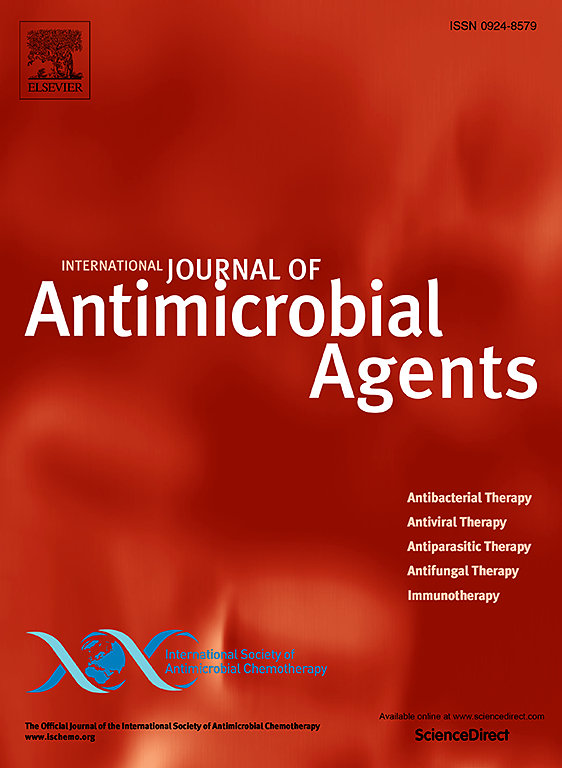Restoring tigecycline efficacy with lysine supplementation in tmexCD-toprJ-positive bacteria
IF 4.9
2区 医学
Q1 INFECTIOUS DISEASES
International Journal of Antimicrobial Agents
Pub Date : 2025-04-15
DOI:10.1016/j.ijantimicag.2025.107511
引用次数: 0
Abstract
Objectives
Antimicrobial resistance is one of the most pressing challenges to global public health. Tigecycline, a last-resort antibiotic, has been undermined by the emergence of the tmexCD1-toprJ1 gene cluster, a transferable RND-type efflux pump that confers resistance. Metabolite-enabled killing of antibiotic-resistant pathogens by antibiotics is an attractive strategy to tackle antibiotic resistance.
Methods
The potentiation of lysine to tigecycline was evaluated through a series of in vitro studies, including bacterial viability assays, time-kill kinetics analysis, persister assays, and biofilm eradication experiments, as well as in vivo assessment using a murine systemic infection model. The underlying mechanisms of action were further explored through transcriptomic profiling and biochemical validation.
Results
Herein, we show that lysine synergistically enhances the antibacterial efficacy of tigecycline against tmexCD-toprJ-positive bacteria. Mechanistic studies indicate that lysine supplementation promotes tigecycline uptake by upregulating ∆pH and disrupting membrane permeability. Transcriptomic analysis, coupled with phenotypic experiments, indicates that lysine not only triggers the generation of reactive oxygen species (ROS) by inhibiting hydrogen sulfide (H2S) production but also downregulates energy metabolism pathways essential for efflux pump function. These effects promote intracellular accumulation of tigecycline, thereby overcoming tmexCD-toprJ-mediated resistance. In mouse infection models, the combination of lysine and tigecycline shows improved therapeutic efficacy compared to tigecycline monotherapy.
Conclusion
Collectively, our findings indicate that lysine can serve as a promising tigecycline booster to tackle infections caused by tmexCD-toprJ-positive bacteria.

补充赖氨酸恢复替加环素对tmexd - toprj阳性菌的疗效
目的抗菌素耐药性是全球公共卫生面临的最紧迫挑战之一。替加环素,一种最后的抗生素,已经被tmexCD1-toprJ1基因簇的出现所破坏,tmexCD1-toprJ1基因簇是一种可转移的rnd型外排泵,赋予耐药性。利用代谢物杀死抗生素耐药病原体是解决抗生素耐药性的一种有吸引力的策略。方法通过一系列体外研究,包括细菌活力测定、时间杀伤动力学分析、持久性测定和生物膜根除实验,以及小鼠全身感染模型的体内评估,来评估赖氨酸对替加环素的增强作用。通过转录组分析和生化验证进一步探索了潜在的作用机制。结果赖氨酸可协同增强替加环素对tmexd - toprj阳性菌的抑菌作用。机制研究表明,赖氨酸的补充通过上调pH值和破坏膜通透性来促进替加环素的摄取。转录组学分析结合表型实验表明,赖氨酸不仅通过抑制硫化氢(H2S)的产生触发活性氧(ROS)的产生,还下调了外排泵功能所必需的能量代谢途径。这些作用促进了替加环素在细胞内的积累,从而克服了tmexd - toprj介导的耐药性。在小鼠感染模型中,与替加环素单药治疗相比,赖氨酸和替加环素联合治疗显示出更好的治疗效果。综上所述,我们的研究结果表明赖氨酸可以作为一种有希望的替加环素增强剂来治疗tmexd - toprj阳性细菌引起的感染。
本文章由计算机程序翻译,如有差异,请以英文原文为准。
求助全文
约1分钟内获得全文
求助全文
来源期刊
CiteScore
21.60
自引率
0.90%
发文量
176
审稿时长
36 days
期刊介绍:
The International Journal of Antimicrobial Agents is a peer-reviewed publication offering comprehensive and current reference information on the physical, pharmacological, in vitro, and clinical properties of individual antimicrobial agents, covering antiviral, antiparasitic, antibacterial, and antifungal agents. The journal not only communicates new trends and developments through authoritative review articles but also addresses the critical issue of antimicrobial resistance, both in hospital and community settings. Published content includes solicited reviews by leading experts and high-quality original research papers in the specified fields.

 求助内容:
求助内容: 应助结果提醒方式:
应助结果提醒方式:


